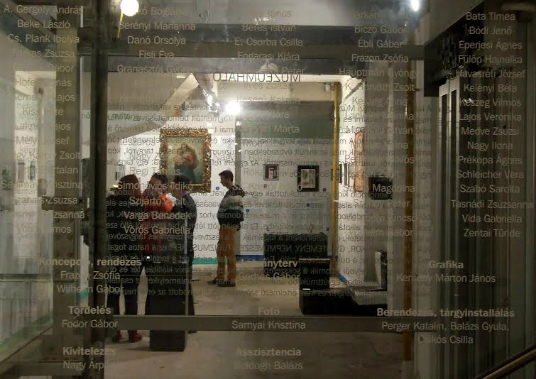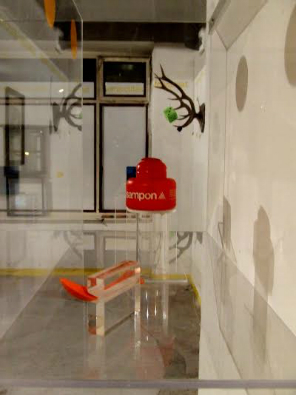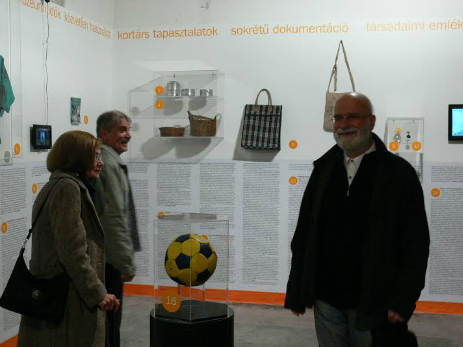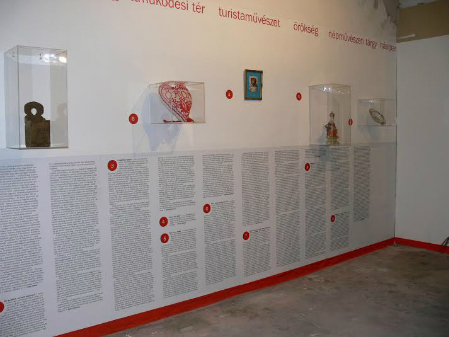Museumnet
EXHIBITION
Zoltán Fejős, the former director of the Museum of Ethnography in Budapest is 60 years old. His friends and colleagues created a surprise exhibition for him in an old building in the centre of Budapest.
| Szijártó Zsolt |
2014-11-26 08:00 |
Zsolt Szijártó (University of Pécs) said this to open the exhibition.

Dear Friends and Colleagues,
From time to time, approaching a symbolic boundary, any community – sometimes even the entire humanity – feels the urge to collect and to make available in some material forms all those technical-cultural-scientific achievements - and the objects which carry these - from a period which this community finds especially important. The 1977 Voyager space capsule carrying small golden plaques featuring messages, photos of this planet and its inhabitants (Sounds of Earth) is a good example of this widespread practice. The objects and texts in this exhibition space here were brought together by a community – a rather divers one including people with different educational backgrounds (curators, university lecturers, artists and critiques) and different motivations – which intended to sketch a portrait of an ethnographer who, according to this material here, likes to do research in very different fields, who is able to re-define institutions and to arrange organisations and people into networks.
 |
 |
|
|
For me then, this exhibition is about creating an object marked as FZ/60, putting it into a time capsule and releasing it for its intergalactic journey, it is like putting up a well-visible orientation point on the horizon – to honour the 60th birthday of Zoltán Fejős.
We could hardly imagine a more suitable venue for this exhibition – the latest enterprise of MaDok LABOR - than this building at 4. Lövölde square (once a soap factory, later a brothel, and now: ground control). The roof is packed with aerials, the functional but cosy room on the first floor with its massive windows with a view on the city is the control room, and downstairs there is this sluice-like entry system, they are all there to serve the purpose of this mission.
 |
 |
|
|
And for this journey back in time, mostly into the last one and an half decades, we could not find a better guide than Zoltán Fejős. His interest in mobility is very well-known: his earliest topics – ethnicity and tourism – concern two phenomena which keep societies constantly moving. However, if we now focus on our narrowed-down scope, flying, it is easy to notice that Zoltán was not put off the topic of aviation even by his legendary vertigo. Some of his writings address his visits to high altitudes – although mostly concentrates on mundane little objects like toothbrush sets, knives, spoons, sleeping masks gathered from airlines like.
And most certainly this is not by chance. Seeing Zoltán Fejős’s career, it has occurred to me several times that gravity does not affect him, or it does it very differently. I don’t know if you have ever attempted to estimate the weight or rather the gravitational force of your institutions and how firmly it presses us to the ground. However, despite these vectors of gravity, in his writings and scientific work – and in my conversations with him – he has always been ready to leave these determinations of everyday life behind. And he has done so with a lot of ease being able to head towards new intellectual galaxies at the edge of the horizon.
Zoltán Fejős’s texts bring us news about stars which are being born right now: he is scanning the contemporary scientific world with remarkable, and, to be honest, with enviable intellectual curiosity – including very remote solar systems. He was the co-editor of the anthropological series of the publisher Osiris and as such he planted the most fundamental cultural anthropological text into social sciences in Hungary. He founded the journal Tabula offering a forum for ethnological-anthropological research. He launched the MaDok books to renew the vocabulary and approaches of contemporary museology and the research of contemporary every day life. Without his work in mediating this knowledge and organizing scientific activities we would understand the contemporary cultural theory of the museum and its objects to a much lesser extent. His contribution to mediating the developments of modern visual culture (most importantly photography, but also films and exhibitions) is also outstanding. It would be a long list, if I wanted to mention the names of those he corresponded about in Hungary first: Marc Auge and John Urry, Elisabeth Edwards and Gottfried Korff, Tony Bennett and Daniel Miller just to mention a few of the present stars in the sky.
At the same time Zoltán Fejős moves around confidently on the surface of remote and already cold celestial bodies: his knowledge of the history of our science which is very obvious behind each of his writings and the research he has guided is more than impressive. To see this clearly it is enough to recall the great number of books recording the collections of the Museum of Ethnography, the re-interpretation of the work of Jószef Huszka, or the exhibition on ancient trades. These are just a few examples of his reflexion on our science, the span of which is quite breathtaking for me. During this work he brought back new topics, forgotten authors and research areas which were suppose to be closed down once and for all.
“In its most surreal form air travel which comprises the entire world is a parallel universe.” Zoltán Fejős quotes the designer Keith Lovegrove in one of his writings. And in this parallel universe in some seconds a new object will take its place, the FZ/60 time capsule, and ground control as well as the professional and amateur astronomers can record the arrival of a new exciting, familiar celestial object which is still awaiting to be discovered.
… and now the countdown: 55, 56, 57, 58, 59, 60. Lift off.